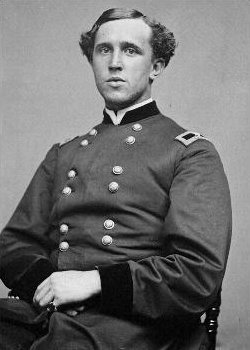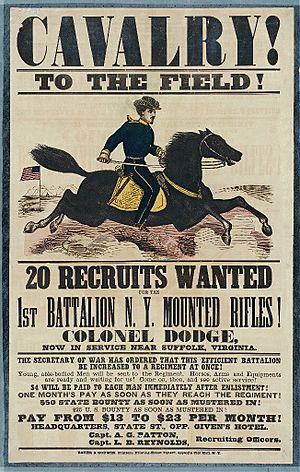Charles C. Dodge facts for kids
Quick facts for kids
Charles Dodge
|
|
|---|---|

Brig. Gen. Charles C. Dodge
|
|
| Born | September 16, 1841 Plainfield, New Jersey, U.S. |
| Died | November 4, 1910 (aged 69) New York City, U.S. |
| Place of burial |
Woodlawn Cemetery, New York City, U.S.
|
| Allegiance | |
| Service/ |
|
| Years of service | 1861–1863 |
| Rank | |
| Commands held | 1st New York Mounted Rifle Regiment |
| Battles/wars | American Civil War |
| Other work | Businessman |
Charles Cleveland Dodge (born September 16, 1841 – died November 4, 1910) was a very young general during the American Civil War. He became a brigadier general at just 21 years old! His father, William Earle Dodge, was a famous businessman and a member of Congress.
Contents
Charles Dodge in the Civil War
Charles Dodge joined the army in December 1861. He became a captain in the 1st Regiment New York Mounted Rifles, a cavalry unit. Soon after, he was promoted to major.
Major Dodge led his cavalry unit during an important mission to Norfolk, Virginia. Before that, his soldiers even fired their weapons from the shore during a famous naval battle. This battle involved powerful ironclad ships like the CSS Virginia.
After the Union army took control of the Norfolk & Gosport Naval Yard, Major Dodge was sent to Suffolk, Virginia. This happened on May 12, 1862. His job was to block supplies from reaching the Confederate forces. He also helped secure roads around the Dismal Swamp.
Confederate forces had already left Suffolk and moved to the Blackwater River. Major Dodge held Suffolk until General Peck took over. General Peck then turned Suffolk into a strong fort with 15 miles of defenses.
Promotions and Key Battles
Dodge was promoted to colonel on August 14, 1862. Then, on November 29, 1862, he became a brigadier general. Many important people from New York, including Theodore Roosevelt Sr., helped him get this promotion.
General Dodge successfully led his troops during the Suffolk Campaign. He also commanded successful battles in Hertford, North Carolina. His mounted riflemen were like the "eyes and ears" for General Peck. They helped find out where the Confederate troops were moving. Dodge's cavalry was the first to spot the movements that led to the siege of Suffolk.
Challenges and Resignation
Even though he performed well, General Dodge had some disagreements with his commanders. These included Major General John J. Peck and Major General John Adams Dix. They preferred an older officer to lead the cavalry division.
There were no other cavalry officers with more experience than Dodge. He refused to be commanded by someone who was younger than him in rank. Because of this, he resigned from the army in June 1863. He briefly returned to help stop the New York City draft riots in New York City.
Life After the War
After the war, Charles Dodge became a businessman. He was a partner in the company Phelps Dodge Co.. He also became the President of the New York and Boston Cape Cod Canal Co.. The United States government later bought this company. They finished building the canal in 1914.
Charles Cleveland Dodge passed away in New York City in 1910. He died from pneumonia. He was buried in Woodlawn Cemetery (Bronx, New York).
Family Connections
Charles Cleveland Dodge came from a well-known family. His family tree shows how he was connected to many other important people.
| Dodge Family | |||||||||||||||||||||||||||||||||||||||||||||||||||||||||||||||||||||||||||||||||||||||||||||||||||||||||||||||||||||||||||||||||||||||||||||||||||||||||||||||||||||||||||||||||||||||||||||||||||||||||||||||||||||||||||||||||||||||||||||||||||||||||||||||||||||||||||||||||||||||||||||||||||||||||||||||||||||||||||||||||||||||||||||||||||||||||||||||||||||||||||||||||||||||||||||||||||||||||||||||||||||||||||||||||||||||||||||||||||||||||||||||||||||||||||||||||||||||
|---|---|---|---|---|---|---|---|---|---|---|---|---|---|---|---|---|---|---|---|---|---|---|---|---|---|---|---|---|---|---|---|---|---|---|---|---|---|---|---|---|---|---|---|---|---|---|---|---|---|---|---|---|---|---|---|---|---|---|---|---|---|---|---|---|---|---|---|---|---|---|---|---|---|---|---|---|---|---|---|---|---|---|---|---|---|---|---|---|---|---|---|---|---|---|---|---|---|---|---|---|---|---|---|---|---|---|---|---|---|---|---|---|---|---|---|---|---|---|---|---|---|---|---|---|---|---|---|---|---|---|---|---|---|---|---|---|---|---|---|---|---|---|---|---|---|---|---|---|---|---|---|---|---|---|---|---|---|---|---|---|---|---|---|---|---|---|---|---|---|---|---|---|---|---|---|---|---|---|---|---|---|---|---|---|---|---|---|---|---|---|---|---|---|---|---|---|---|---|---|---|---|---|---|---|---|---|---|---|---|---|---|---|---|---|---|---|---|---|---|---|---|---|---|---|---|---|---|---|---|---|---|---|---|---|---|---|---|---|---|---|---|---|---|---|---|---|---|---|---|---|---|---|---|---|---|---|---|---|---|---|---|---|---|---|---|---|---|---|---|---|---|---|---|---|---|---|---|---|---|---|---|---|---|---|---|---|---|---|---|---|---|---|---|---|---|---|---|---|---|---|---|---|---|---|---|---|---|---|---|---|---|---|---|---|---|---|---|---|---|---|---|---|---|---|---|---|---|---|---|---|---|---|---|---|---|---|---|---|---|---|---|---|---|---|---|---|---|---|---|---|---|---|---|---|---|---|---|---|---|---|---|---|---|---|---|---|---|---|---|---|---|---|---|---|---|---|---|---|---|---|---|---|---|---|---|---|---|---|---|---|---|---|---|---|---|---|---|---|---|---|---|---|---|---|---|---|---|---|---|---|---|---|---|---|---|---|---|---|---|---|---|---|---|---|---|---|---|---|---|---|---|---|---|---|---|---|---|---|---|---|---|---|---|---|---|---|---|---|---|---|---|---|---|---|---|---|---|---|---|---|---|---|---|---|---|---|---|---|---|---|---|
|
|||||||||||||||||||||||||||||||||||||||||||||||||||||||||||||||||||||||||||||||||||||||||||||||||||||||||||||||||||||||||||||||||||||||||||||||||||||||||||||||||||||||||||||||||||||||||||||||||||||||||||||||||||||||||||||||||||||||||||||||||||||||||||||||||||||||||||||||||||||||||||||||||||||||||||||||||||||||||||||||||||||||||||||||||||||||||||||||||||||||||||||||||||||||||||||||||||||||||||||||||||||||||||||||||||||||||||||||||||||||||||||||||||||||||||||||||||||||
See also
- List of American Civil War generals (Union)


